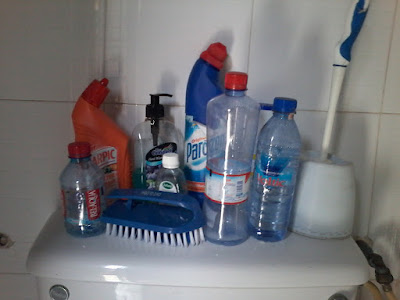 |
| Domestic plastic products |
I just went over to the other
side of the main road (La Road, formerly Labadi Road) to buy kenkey and wakye.
Both meals were served in plastic bags. Kenkey is milled corn cooked and rolled
into balls. As a meal it goes with ground pepper and fried fish. Wakye, another
Ghanaian meal is cooked rice and beans which goes with hot black pepper and meat
or fish. As I said both meals were served in plastic bags. Back in the house I
looked around me to assess the house’s plasticity.
PERVASIVE
The very laptop I am using now to
pen this post is very plastic. The spectacles I am wearing to type my post is
fully plastic. The refrigerator I use in the house is plastic. The flip flop on
my feet as I pen this post is plastic. The sole of the Converse All Star canvas
I am using is plastic. The LG television I use is plastic. The two radios I
have in the house are plastic. The remote controls I have in the house are
plastic. The mobile phone I use is plastic. The cord connecting my laptop to the socket
and through which power is fed to the laptop is plastic. The socket from which
I draw the power is plastic. The inner unit of the air conditioner in the house
is plastic. The fan I use in the house is plastic. All the wiring in the house
are insulated by plastic. Piping of the house are made with plastic. The WC
seat is plastic. The water tank I store water in is plastic. The water hose I
use in tending my garden is plastic. The pan I use in collecting rubbish is
plastic. The bowls and buckets are plastic. The toothbrush I use in brushing my
teeth is plastic. The tube in which the toothpaste is kept is plastic. The
water bottles, the antiseptic bottles, the detergent bottles, brushes and
lavatory bowl seat are made of plastics.
This is just one home, when it is
replicated to cover all homes you should appreciate the magnitude of our
society’s plasticity; more so when you add industries, offices, hospitals etc.
Perhaps you have not thought of it that way. Is it a plastic age?
WASTE
The waste generated from the
consumption of plastic end up in the water bodies of planet Earth. Some of the
waste gather at gyres of the oceans and some end up on the beds of the water
bodies. Some plastic get buried in the soil. The end result is a dirty and an
imbalanced natural environment. Suppose we manage the waste better than we are
doing right now we should be telling a different story.
DEFINITION
In Ghana, West Africa, plastic is
commonly called rubber. According to the Collins English dictionary plastic is
any of the large number of synthetic materials that have a polymeric structure
and can be moulded when soft and then set.
How plastic is made:
CHEMISTRY
To know how plastic is made we
must know something about its chemistry. There is a process called
polymerization. It is the process whereby simple molecules chemically combine
to form a large chain of molecules. The large chain of molecules so formed is
called polymer (the definition of plastic indicated already refers to a
polymeric structure). The simple molecule involved in the process is called
monomer. To get a product with features such as elasticity and high ability to
withstand pressure and weight, a minimum of one hundred monomer molecules must
be combined. Remember that a molecule is a combination of two or more atoms,
and an atom is the basic chemical unit of an element, and elements are the
basic substances of the natural environment. The elements when put together as
whole form the natural environment.
 |
| The process of polymerization |
AS A
CONSUMABLE
For plastic material to become a
consumable, it must pass through a process. The plastic material must be
heated, molded and made solid by cooling to get the required product. An
example is the conversion of plastic pellets into film. Film is a thin sheet of
plastic for packaging.
Reference:
http://chemistry.tutorvista.com/organic-chemistry.html
Comments
Post a Comment